Virginia
| |
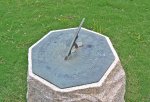 |
Jamestown |
Virginia |
USA |
Horizontal Dial |
Dial 724 |
| A 15 inch octagonal bronze horizontal dial with a bronze gnomon. Dial face shows hour, half-hour, quarter-hour and 5-inute marks with Roman hour numerals. The gnomon is damaged and analysis shows the dial hour lines are laid out for approximately 45° latitude instead of the local 37° latitude. The dial is on a white granite pillar. |
| |
| |
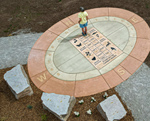 |
Janesville |
Wisconsin |
USA |
Analemmatic Dial |
Dial 1065 |
| This 21 ft x 16 ft (7m x 5m) analemmatic sundial has a landscaped area with seating and a stone pier that holds a bronze dedication plaque and a bronze information plaque with a QR code for additional online information. The central zodiac walkway is a 2,500 pound pre-cast concrete slab that includes images of regional plants and animals next to their corresponding months to represent seasonal cycles as a reminder that nearly all life on earth is connected to the relative motions and positions of the sun and earth. The bronze hour numerals and bronze cardinal point letters are anchored into poured concrete rings that surround the walkway. The analemmatic sundial is modeled after the one at the Milwaukee County Botanical Domes. |
| |
| |
 |
Jemez Springs |
New Mexico |
USA |
Analemmatic Dial |
Dial 552 |
| Analemmatic dial of cast concrete 6m E-W by 2.2m N-S |
| |
| |
|
Jerico |
Vermont |
USA |
Horizontal Dial |
Dial 70 |
| 50 foot diameter horizontal dial of steel, concrete and stone. Called "Polaris". The gnomon is 10 foot high forming a stone pyramid. As the sun shines through a hole at the center, an analemma is traced on the ground. Markers identify equinox sunrises and solstice sunsets. The dial was built by Kate Pond and her students. See NASS Compendium Vol 1, No. 2, May 1994. |
| |
| |
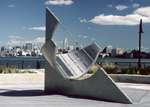 |
Jersey City |
New Jersey |
USA |
Equatorial Dial |
Dial 1091 |
| The equatorial sundial is a classic "bow string" sundial using a thin rod with a nodus to tell both time and date. The nodus is a small disk with a hole in the center to let a beam of sunlight fall near the noon hour line on the equatorial ring. The equatorial ring (a semi-circle) as the rest of the dial is stainless steel, The dial is 12 feet (4m) at the base and 12 feet (4m) in height, forming a 45 deg triangle in profile. |
| |
| |
|
Jersey City |
New Jersey |
USA |
Horizontal Dial |
Dial 434 |
| A horizontal dial 12 feet across made of concrete and pipe. |
| |
| |
 |
Johnson |
Vermont |
USA |
Horizontal Dial |
Dial 71 |
| One of Kate Pond's first dials, a winning design for an 18 foot diameter dial that now resides on the University of North Vermont - Johnson green. Concrete, Stainless Steel. On the ground concrete paths mark the N-S and E-W axes. The gnomon is a 3 inch stainless steel pipe 9 feet long attached to a concrete base. The hours are marked with 1 foot diameter Vermont granite stones, and at the cardinal points are larger stone markers. Kenneth Leslie, Assistant Professor of Art, remarked, " I have the idea of a student sitting against the North marker, reading a newspaper for a noon class, and knowing it's time to leave when the shadow crosses his paper." |
| |
| |
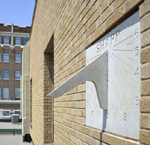 |
Joplin |
Missouri |
USA |
Vertical Dial |
Dial 979 |
| This is a simple but nicely engraved vertical sundial about 2-foot square made of concrete. The hour lines are delineated every half hour and marked on the hour in Arabic numbers. The gnomon is at least 1-inch thick, now epoxied into place. The hour lines converge correctly to the morning and afternoon toe of the gnomon, but no split noon hour line is seen. The dial is slightly recessed into the brick wall on the eastern edge correcting the Joplin street lay out of 1873 that used magnetic north that was 10 degrees east of north. |
| |
| |
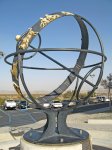 |
Joshua Tree |
California |
USA |
Armillary Sphere |
Dial 625 |
| A 5 foot diameter steel armillary sphere with 6 foot gnomon rod. Inner surface of equatorial ring has cast Roman numerals; outer surface has cast Zodiac signs colored gold. Sphere is supported by 13 inch high four-flange base. Dial sits on a 42 inch high cast concrete cylindrical base. |
| |
| |
 |
Juneau |
Alaska |
USA |
Analemmatic Dial |
Dial 454 |
| Painted on a downtown sidewalk is an analemmatic sundial for public use. The 25 x 20 foot sundial was organized as a community project. Eden Orelove, niece of designer Michael Orelove said, "We wanted to get as many school classes and local volunteer organizations involved as possible." Groups were invited to join the project by painting the hourly numbers. Two concentric ring of numbers are used to indicate both standard and daylight saving time, which extends from 4 am to 10 pm. |
| |
| |
 |
Kalamazoo |
Michigan |
USA |
Analemmatic Dial |
Dial 430 |
| A modernistic analemmatic dial. The ellipse is a raised stone wall with large Arabic numbers for each hour from 5am to 7 pm. The concrete patio in front of the wall contains the analemmatic line of months as an indicator of where to stand for casting the shadow. |
| |
| |
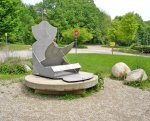 |
Kalamazoo |
Michigan |
USA |
Compound Dial |
Dial 733 |
| A combination horizontal, vertical, polar and equatorial dial 4 x 5 x 6 foot tall made of drilled aluminum plate with rod gnomon. The vertical plate shows the EOT graph and depiction of Earth showing polar tilt, celestial equator and Earth equator using drilled holes. The bottom plate below the equatorial face includes a compass rose that also shows the direction of sunrise and sunset at the solstices. All dial faces are marked using Arabic numerals with hour and 15 minute marks.
The Kalamazoo Nature Center is open most days and charges an admission fee. |
| |
| |
|
Kalamazoo |
Michigan |
USA |
Horizontal Dial |
Dial 96 |
| Large circular bench ca 25' in diameter forms ring with hour markings. Aluminum or stainless steel gnomon. Relatively new. |
| |
| |
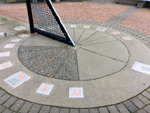 |
Kamloops |
British Columbia |
Canada |
Horizontal Dial |
Dial 959 |
| A simple horizontal dial consisting of a 6' gnomon made of black-painted steel tubes set in a circular concrete patio.The dial is located in a pleasantly laid out xeno garden (planted for arid conditions) with benches and a pergola. A riverside walk passes close by, and the whole area is designated for recreational and sports use. The gnomon is unusual for its plain industrial feel, and the use of wire mesh to fill in the gnomon's triangular substyle area. As well, the north end of the gnomon is formed by a pole that extends an extra 6' upwards, topped off by a weather vane. |
| |
| |
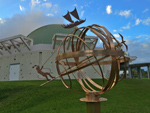 |
Kaneohe |
Hawaii |
USA |
Armillary Sphere |
Dial 543 |
| A 32-inch diameter bronze armillary dial with extensive Polynesian-themed motif. An integral plaque provides corrections for EOT and longitude within HST. The armillary includes ten bronze rings: horizon; solstitial colure (meridian); equinoctial (equator); Tropic of Cancer; Tropic of Capricorn; Arctic circle; Antarctic circle; "prime vertical circle" perpendicular to the meridian circle and horizon that spans from east to zenith to west; equinoctial colure perpendicular to meridian circle and equator passing through the north and south poles; and an "upright ring" inscribed with Zodiacal signs between the prime vertical and equator. |
| |
| |
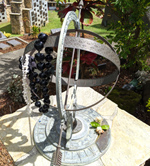 |
Kaneohe |
Hawaii |
USA |
Horizontal Dial |
Dial 715 |
| the original 12 inch diameter bronze horizontal dial has been replaced with a large armillary. The bronze meridian ring is approximately 24-inch in diameter. The equatorial band is about 4-inches wide with Roman numerals marking the hours. The gnomon is a traditional arrow rod. The dial base is approximately 12-inches in diameter with the zodiac names, pictograph, and symbols surrounding the dial. The dial base rests on a square pedestal of mortared stone . |
| |
| |
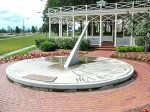 |
Kannapolis |
North Carolina |
USA |
Horizontal Dial |
Dial 703 |
| A large horizontal cast concrete dial on a brick patio. Dial face includes hour lines and Roman numerals. Dial is dedicated as a tribute to the men and women of Kannapolis who died while serving in the US armed forces. |
| |
| |
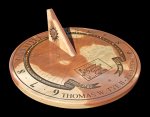 |
Kearney |
Nebraska |
USA |
Horizontal Dial |
Dial 722 |
| A 32 inch diameter bicolored Coconino sandstone horizontal dial with hour, half and quarter hour marks and Arabic hour numerals showing DST with longitude correction. The large noon gap is marked, High Noon. Dial face has carved time ribbon with inlayed brass balls on quarter hours. Gnomon sides show carved sunface and moonface. Dial is placed on a cast concrete pedestal approximately 20 inches high. |
| |
| |
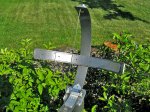 |
Kelowna |
British Columbia |
Canada |
Equatorial Dial |
Dial 716 |
| An approximately 18 inch diameter equatorial dial of brushed aluminum and stainless steel with painted steel equatorial and meridian supports. Hour lines and Arabic hour numerals are marked on dial face and a bow string gnomon is tensioned by the meridian arc, which is adjustable for latitude and provided with a marked scale. Meridian arc is supported on a 3-inch diameter steel pole fixed in concrete. |
| |
| |
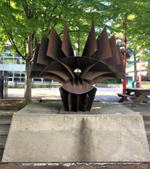 |
Kelowna |
British Columbia |
Canada |
Shadow Plane Dial |
Dial 960 |
| It is a large sculpture that acts as a shadow plane dial delineated at hourly intervals. The dial is about 3m high. It is made of mild steel with a concrete base, very precisely cut and installed. It shows local solar time, delineated at hourly intervals. Each shadow plane projects onto a small vane that has notches cut out, the number of notches indicating the hour. This dial is one of the earlier artworks by Alan Storey, a successful Canadian sculptor specializing in large-scale public art. The setting is a pleasant tree-lined courtyard at the center of the campus. in the years since the courtyard was laid out and the dial installed, the trees have grown large and cast shade on the dial. The best time to view the dial in sun is probably mid-morning, or in the winter when deciduous trees have lost their leaves. |
| |
| |
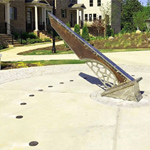 |
Kennesaw |
Georgia |
USA |
Horizontal Dial |
Dial 948 |
| Developers of Kennesaw Gateway Park, a new group of townhouses within walking distance of of town center, collaborated with Kennesaw State University (KSU) to design and fabricate a 9-foot tall horizontal sundial that has been placed in the circular plaza of the housing common area. Page Burch, a lecturer of KSU's Master Craftsman Program was the lead coordinator to design and fabricate the sundial gnomon. The stainless steel gnomon has a brass veneer and an unusual tilted based that nevertheless results in the the gnomon angle of 34 degrees exactly correct for the site latitude. |
| |
| |
 |
Kennett Square |
Pennsylvania |
USA |
Analemmatic Dial |
Dial 328 |
| 37.2 ft x 23.8 ft. This is probably the world's largest analemmatic, unusually designed to show standard time directly. It took 8 years of daily readings to perfect the sundial, which is accurate to within 2 minutes. Hour markers are bronze Roman numerals. Minute lines inscribed in limestone curbing. The gnomon itself is a moveable pole that is set on an AM or PM daily curve. NASS member P. Kenneth Seidelman was instrumental in correcting this design in 1978. |
| |
| |
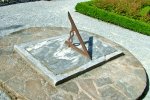 |
Kennett Square |
Pennsylvania |
USA |
Horizontal Dial |
Dial 329 |
| Dating from 1976, this "secret" garden room (once a sundial garden with boxwood parterre) was designed by Thomas Church and is on the western side of the 1908 Square Fountain pool. The ground level horizontal dial is limestone with an iron gnomon. Hour lines identified by Roman numerals; hours divided into minutes. Hour line distribution adjusted for style width. EoT engraved on PM side of dial face. Dial sits atop a large mortared stone base. |
| |
| |
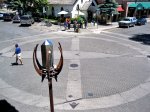 |
Ketchum |
Idaho |
USA |
Gnomonic or Projection Dial |
Dial 582 |
| This sundial was never finished. Update 8/10/2007 from Brad Needham: Thanks for the question about the Ketchum sundial. It's a puzzling work, and it took me quite a few Google searches to find a bit of the story: evidently a local (to the Ketchum area) sculptor submitted a sundial design to the city, and somehow the deal fell apart after the dial was made but before the sculptor finished the gnomon. So Ketchum is left with all the markers in the street intersection for the equinox, the noon summer and winter solstices, and an analemma (of some sort), but no gnomon to make it all work. |
| |
| |
 |
Kingston |
Ontario |
Canada |
Vertical Dial |
Dial 450 |
| A square pillar of limestone rocks 4 foot on a side and 15 feet high with a small bowl and sphere on top hold two vertical dials each 2x2 feet. The pillar faces are oriented SE and SW allowing for two declining dials. The dials are of solid brass and have hour lines with Arabic numbers in a modern design belying by the stonework of the pillars. Unfortunately the 14-inch gnomons are bent |
| |
| |
|
Knoxville |
Tennessee |
USA |
Horizontal Dial |
Dial 166 |
| 78" w x 168" h x 78" d Steel, brass & etched glass As the sun penetrates the building a shadow is cast from the gnomon onto the 1 inch thick laminated glass which has hour lines etched into its surface. The time is viewed from the underside of the dial. A deep carved mountain landscape is artificially lighted in the lower section. |
| |
| |
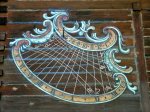 |
Kohler Village |
Wisconsin |
USA |
Vertical Dial |
Dial 290 |
| A direct east vertical dial approximately 5 feet square, ornately painted onto the side of the Waelderhaus at Kohler Village. The Waelderhaus is a tribute to the tradition of Bregenzerwald, a province of Vorarlberg, Austria, and represents the architecture of this particular Alpine Area. The dial is painted in gold and white with flourishes. A top scroll shows hours with Arabic numerals while a bottom scroll shows the hours with Roman numerals. Lines for solstice, equinox, and signs of the zodiac are drawn across the faces of the dial. No analemma is drawn. |
| |
| |
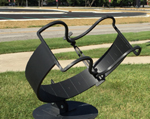 |
Kokomo |
Indiana |
USA |
Equatorial Dial |
Dial 826 |
| This is a hammered wrought iron equatorial sundial approximately 30 inches in diameter with a 6 inch equatorial band. The gnomon is a thin rod bracketed by an iron slit that is manually rotated to allow a bright beam of light to surround the shadow time-telling mark. The dial is designed to show local solar time, and requires the Equation of Time to correct for the tilted earth’s rotation axis and its eccentric orbit around the sun. |
| |
| |
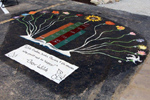 |
Kokomo |
Indiana |
USA |
Analemmatic Dial |
Dial 867 |
| This brightly decorated analemmatic sundial is painted on the asphalt to look like a book turning into flowers, showing the combination of literacy and nature. The dial is approximately 10 foot wide with hour marks from 5am to 7pm with drawings of various flowers. Noon is marked with a large sunflower. The central walkway is simply done with the abbreviated names of the months, one column in green, the other in red. |
| |
| |
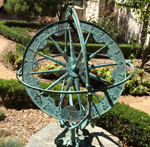 |
La Canada |
California |
USA |
Armillary Sphere |
Dial 881 |
| The bronze equatorial dial is about 24" diameter, and has equatorial, meridian and horizon rings. It sits on top of a stone pedestal. The equatorial ring is supported by 24 spokes, spaced at 15 degrees. Around the rim 24 hour numerals in Arabic. The twelve signs of the zodiac are spaced every other hour on the equatorial rim. The orientation to true north and inclination were verified to be correct for the site. The sundial was a gift from the Kresser Smith family to the Descanso Gardens Guild in 1987 on the occasion of the guild's 30th anniversary. |
| |
| |
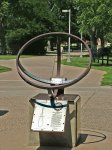 |
La Crosse |
Wisconsin |
USA |
Equatorial Dial |
Dial 217 |
| A 40 inch diameter armillary on a 2 foot tall cement cubic base. The original analemma-shaped gnomon was missing and replaced with a section of loose ordinary electric wire. Includes a longitude-correction plaque showing the corrections throughout 15 degrees longitude. Dial sits atop a 26 inch high, 26 inch square pedestal. Robert Allen states that this dial is a scaled down version of the one at the San Diego Zoological Garden, and that there is a similar one at Williams College in Williamstown MA. |
| |
| |
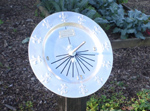 |
La Grange |
Kentucky |
USA |
Equatorial Dial |
Dial 955 |
| This equatorial dial is improvised using a 13 inch diameter aluminum plate embossed with fleur de lis around the perimeter. Hour lines run from 6am to 6pm with Arabic markers only at 12 and the 6's. |
| |
| |
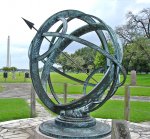 |
La Porte |
Texas |
USA |
Armillary Sphere |
Dial 216 |
| Approximately 6 foot diameter bronze armillary dial with equatorial, meridian and equinoctial colure rings and with Arctic and Antarctic circle rings. Hour lines have 5 minute marks and Roman numerals. Equatorial ring has Zodiacal signs. Base shows the Great Seal of Texas and includes a bronze eternal flame.
Names of fallen heroes are inscribed on the base and paths to and from the dial lead to location of Sam Houston's troops prior to the battle of San Jacinto. The San Jacinto Monument is seen in the distance. |
| |
| |
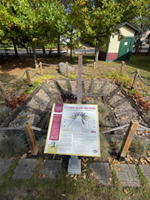 |
Labelle |
Quebec |
Canada |
Horizontal Dial |
Dial 1138 |
| The dial is a square 1.7m x 1.7m structure in the ground using railroad ties as the perimeter and as the hour lines from 6am to 6pm. Hours are marked in Roman numerals. The style of the gnomon is made out of a portion of a railroad track, supported by odds and ends of railroad ironwork. |
| |
| |
 |
Lafayette |
Indiana |
USA |
Equatorial Dial |
Dial 376 |
| An 8 foot high equatorial dial of welded stainless steel with a brass gnomon and brass equatorial ring. The 60 inch diameter equatorial ring is engraved with hour marks and Roman numerals. Dial was commissioned by the cities of Lafayette and West Lafayette in celebration of the Millennium. Dial sits atop a short concrete pedestal. |
| |
| |
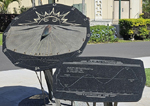 |
Laie |
Hawaii |
USA |
Vertical Dial |
Dial 1105 |
| To accommodate Hawaii's low latitude, this is a reclining sundial more than a meter (3 feet) in diameter and stands over 2 meters (6 feet) tall. It is carved from a dark, igneous stone with a bronze conical gnomon and set on bronze legs. The sundial includes a separate, stone-carved legend that includes an explanation of how to correct the gnomon shadow-time indicated on the dial for the time of year. The sundial, taken as a whole is reminiscent of a bird, enhanced by the conical gnomon and sun on the horizon given two eyes. At the edge of the dial are symbols of the zodiac |
| |
| |
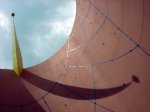 |
Lake Buena Vista |
Florida |
USA |
Gnomonic or Projection Dial |
Dial 221 |
| Conical dial 120 ft. high, 122 ft. diameter at base and has an 85 ft circular opening to the sky. In the middle of the opening is a spherical nodus that casts its shadow into the concrete structure. According to the Guinness Book of Records in 1995, this is the world's largest sundial. Designed by Isozaki and calculated by Ross McCluney, the sundial is a large truncated, slanted cone, with hour markings on the inside. McCluney was NASS's first president. |
| |
| |
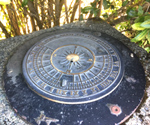 |
Lake Cowichan |
British Columbia |
Canada |
Horizontal Dial |
Dial 989 |
| This is a beautiful but standard mass-produced dial, with chapter rings for Roman numerals, hour lines, half and quarter hour lines. In the center is the sun surrounded by a compass rose, The dial itself is brass, but sits on a round cast iron base all sitting on a square concrete pillar. The gnomon was vandalized and now is missing. The base is losing its protective coat of paint and starting to rust. A thick hedge has grown up around the sundial, obscuring the sun on the east, south and west sides. It appears to be largely ignored. |
| |
| |
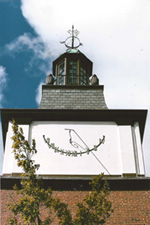 |
Lake Forest |
Illinois |
USA |
Vertical Dial |
Dial 805 |
| A vertical south-facing dial, simple in design and visible to the shoppers in the U-shaped town square below. The dial face is plane white with Roman hour numbers fastened to a rod bent in an ellipse. No other delineation (such as solstice and equinox lines) is on the dial face. The gnomon is a simple rod held by an "S" shaped support. |
| |
| |
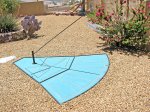 |
Lake Havasu City |
Arizona |
USA |
Horizontal Dial |
Dial 647 |
| An 8 x 9 foot horizontal dial of powder coat painted aluminum panels 1/4-inch thick assembled onto a concrete pad. Perimeter shows Arabic hour numerals 9-2 with 5-minute dots placed in arcs below the numerals. EOT correction is provided through four graphics on the dial face under the gnomon and sliding "T Square" indicators showing the corrections on rulers. EOT values are corrected for longitude. Dial face plates are supported on poured concrete pad.
Dial is on private property. Contact the owner to arrange viewing. |
| |
| |
 |
Lake Oswego |
Oregon |
USA |
Analemmatic Dial |
Dial 763 |
| An analemmatic dial with 20 foot major axis, 14 foot minor axis with hour markers and date line made of sandblasted concrete paver stones. A platform stand on the west side holds instructions on using the dial.
A preliminary version of this dial was included on the 2009 NASS Conference Sundial Tour. |
| |
| |
 |
Lake Wales |
Florida |
USA |
Analemmatic Dial |
Dial 562 |
| A large stone analemmatic in the Endangered Plant Garden. |
| |
| |
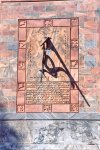 |
Lake Wales |
Florida |
USA |
Vertical Dial |
Dial 36 |
| Beautiful vertical dial, approx 12x6 foot of Georgia marble with a brass gnomon approx 5 foot long. Declination lines present. Hour & half hour lines with hours in Roman numerals. Sunburst pattern above gnomon. From the Guidebook, published by the Garden: 'The famous sundial carved on the south wall of the Tower indicates the latitude and longitude of Iron Mountain. It is known as an erect declining dial as it stands vertically at an exact right angle with the surface of the earth... and does not face directly south but is tilted towards the east with a declination of 4 degrees, 20 minutes.' It has an Equation of time chart and shows the days of the months as well. Directions are to 'Add minutes shown for each day to obtain Eastern Standard Time.' |
| |
| |
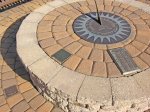 |
Lakewood |
New Jersey |
USA |
Horizontal Dial |
Dial 540 |
| A horizontal dial of cast brass or bronze with a 2-foot diameter dial face showing hours in Roman and Arabic numerals. Coordinates and EOT corrections are shown as is the university motto, "Georgian Court: Bonitas, Disciplina, Scientia." Sundial face is also the sun in a scale model of the solar system, with the planets depicted in brass plaques placed at to-scale distances. |
| |
| |
 |
Lakewood |
New Jersey |
USA |
Horizontal Dial |
Dial 615 |
| A one-foot diameter bronze horizontal dial on a carved marble base depicting three satyrs holding up the dial. Sundial is original to the Gould estate, now Georgian Court University campus. The dial is supported by a carved marble sculpture depicting three satyrs. |
| |
| |
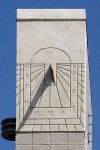 |
Lampeter |
Pennsylvania |
USA |
Vertical Dial |
Dial 545 |
| A 32x64-inch cast stone vertical declining dial located 25 feet up a vertical column at the school's entrance. An EOT plaque is located below the dial. |
| |
| |
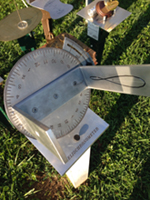 |
Lancaster |
Pennsylvania |
USA |
Heliochronometer |
Dial 875 |
| This 7.5 inch diameter heliochronometer was milled out of aluminum and set to the site latitude with a mounting plate. One heliochronometer arm has a sun illumination counter sunk hole 0.125 inch in diameter and on the other arm an engraved analemma for proper pointing offset to display civil time. Time marks are milled at 5 minute intervals, and a vernier is added (5 lines 4 minutes apart) so that time can be read to the nearest minute. |
| |
| |
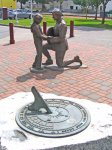 |
Langford |
British Columbia |
Canada |
Horizontal Dial |
Dial 736 |
| A cast bronze horizontal dial with thick bronze gnomon. Dial face shows hour lines and quarter-hour marks, and Roman hour numerals. Dial center includes a compass rose. |
| |
| |
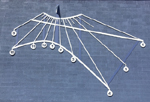 |
Lansing |
Michigan |
USA |
Vertical Dial |
Dial 923 |
| This is a vertical, east-declining sundial, 22 ft 6 in by 15 ft 10 in. The dial is constructed of 6061 aluminum alloy pieces electrostatically painted and bolted together,then mounted on a concrete block wall. The position of the gnomon, hour, solstice, and equinoctial lines are corrected for longitude to show time zone solar time. Stenciled hour line numbers are changed to display DST or EST at appropriate times of the year. Visitors can determine the correct time by referring to an Equation of Time display. During the year, the triangular gnomon tip casts its shadow on the declination lines of summer and winter solstices and equinoxes. This is the largest known vertical sundial in Michigan, and one of the largest in the United States. |
| |
| |
|
Laramie |
Wyoming |
USA |
Horizontal Dial |
Dial 159 |
| An ornate 18 inch brass horizontal dial sits on a massive four-stone block pedestal. The dial has hour lines from 4am to 8pm, with hours in roman numerals. Time is graduated into 5-minute intervals. The 12-noon mark is 3/8 inch wide, allowing for the gnomon which is missing. |
| |